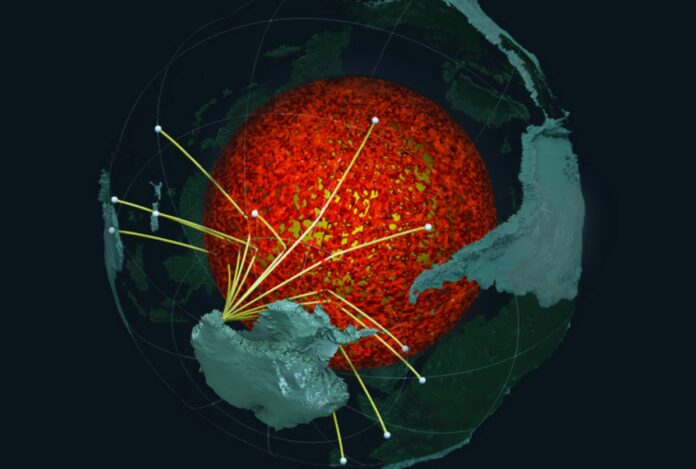According to the study, the thickness of the structure varies from just a few kilometers to tens of kilometers. “This suggests we are seeing mountains on the core, in some places up to 5 times taller than Mt. Everest.”
A team of scientists led by The University of Alabama used global-scale seismic imaging of Earth’s interior to uncover a dense but thin layer between the core and the mantle. Their findings, which suggest that this layer is likely a sunken ocean floor, were published today in Science Advances.
Previously only observed in isolated areas, the latest seismic data indicates that this layer of ancient ocean floor may actually surround the core-mantle boundary. The oceanic material was likely subducted underground during the shifting of Earth’s plates and has created an ultra-low velocity zone (ULVZ) that is denser than the surrounding deep mantle, causing a slowdown in seismic waves reverberating beneath the Earth’s surface.
“Seismic investigations, such as ours, provide the highest resolution imaging of the interior structure of our planet, and we are finding that this structure is vastly more complicated than once thought,” explains lead author Dr. Samantha Hansen. “Our research provides important connections between shallow and deep Earth structure and the overall processes driving our planet.”
Using these subtle signals, researchers were able to create a map of a variable layer of material that is pencil-thin and measures in the tens of kilometers. This is in contrast to the Earth’s dominant layers, which are much thicker. The anomalous coating at the core-mantle boundary is characterized by strong wave speed reductions, leading to its classification as an ultra-low velocity zone (ULVZ).
The presence of ULVZs can be attributed to former oceanic seafloors that have sunk to the core-mantle boundary. When two tectonic plates meet and one subducts or dives beneath the other, oceanic material is carried into the Earth’s interior. Over time, accumulations of subducted oceanic material collect along the core-mantle boundary and are pushed by the slowly flowing rock in the mantle. The distribution and variability of this material explain the observed properties of ULVZs.
ULVZs can be compared to mountains along the boundary between the Earth’s core and mantle. These underground formations can have heights ranging from less than 3 miles to over 25 miles.
“Analyzing 1000’s of seismic recordings from Antarctica, our high-definition imaging method found thin anomalous zones of material at the CMB everywhere we probed.” adds Garnero. “The material’s thickness varies from a few kilometers to 10’s of kilometers. This suggests we are seeing mountains on the core, in some places up to 5 times taller than Mt. Everest.”
The newly discovered underground mountains, believed to be ancient ocean floors, could be a crucial component in the escape of heat from Earth’s core, which powers the planet’s magnetic field. The material from these mountains can also be carried by mantle plumes or hot spots, and reach the surface through volcanic eruptions.
At a depth of around 2,000 miles, the Earth’s rocky mantle meets the molten outer core, which is made of metal. The differences in physical properties across this boundary are even greater than those between the solid rock on the Earth’s surface and the air above it.
Dr. Samantha Hansen, along with her students and an international team, deployed a seismic network in Antarctica for three years during four trips to better understand the composition of the core-mantle boundary. The network consisted of 15 buried stations that used seismic waves from earthquakes worldwide to create an image of the Earth below, similar to a medical scan.
The project probed a large portion of the southern hemisphere in high resolution for the first time using a detailed method that examines sound wave echoes from the core-mantle boundary. Unexpected energy was identified in the seismic data that arrived within several seconds of the boundary-reflected wave.
Source: 10.1126/sciadv.add4838
Image Credit: Edward Garnero and Mingming Li, Arizona State University
